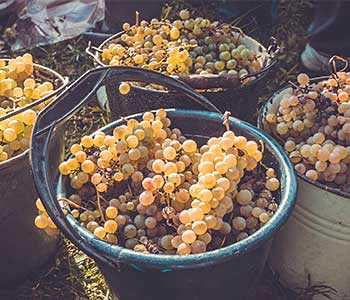
Pros and cons of harvesting grapes by machine
More and more often you can read on wine labels: "Pure manual labor". This is because wine production has long been fully automated and mechanized in many places. Of course, this also applies to the harvest. That is why many small winegrowers – especially those working organically and biodynamically – feel obliged to communicate their handicraft methods. How mechanical harvesting works and what the advantages and disadvantages are, I have compiled here.
September 2021
Translated with DeepL
The grape harvest is in full swing. Since the beginning of September this year a bit later than in the previous ones. For winegrowers, this is the most important time of the vineyard season; now everything has to run like clockwork. The harvest teams work from early in the morning until sunset – as do the cellar masters and wine presses, so that the grapes can be pressed as quickly as possible and the must can reach the cool cellar. And then – there are the grape harvesters. They save labor, time and money.
I have not yet seen a harvester in use, but I have seen vineyards harvested by them. This can be recognized by the fact that the de-stemmed empty stalks hang on the vines and the tire tracks of the machines can be seen on the ground. The harvesting machines were developed in the USA in the 1960s. The vines must have a certain height for this purpose and the vine rows a certain distance apart so that there is enough space for the harvester. The harvester forms a tunnel above the row and shakes the ripe berries from the vines onto a conveyor belt, blowing out interfering leaves and small branches. The grapes are then transferred to a container, which is transported to the winery. To illustrate how it works, here is a short film. While harvesting machines used to be possible only in flat vineyards, there are now also grape harvesters for steep slopes. Modern machines work precisely and quickly, managing up to half a hectare of harvest per hour. This saves the winery from having to find scarce labor, large sums of wages, and the lodging and food for seasonal workers. Even weather hazards such as heavy or continuous rain are less of a threat if the machine is started in time and can quickly bring in the grapes. The harvest is not diluted and rot is less of an issue.
However, the disadvantages outweigh the benefits for many winegrowers: The soil compression caused by the heavy machines is literally a weighty argument against it. The berries are often damaged and have to be processed particularly quickly. The grape stems, which are frequently crushed or fermented for some wine styles and red wines, remain on the vine in the vineyard. And if you want to harvest the grapes with particular precision in several picking rounds, because the grapes ripen differently, mechanical picking is not the right choice either. However, the most significant disadvantage of mechanical harvesting is the social aspect. Instead of creating jobs, they are destroyed. Working together, joint meals and the joy – felt even when tired – of the harvest brought in every day have always made this time special. That is eliminated, and especially the end of the harvest, which is celebrated extensively at many wineries. Too bad!
Organic farming, by the way, allows machine harvesting. Only biodynamic viticulture prescribes hand harvesting. This applies equally to Biodyvin, Demeter and respekt-BIODYN. Grape quality, soil vitality and the social function of hand harvesting are paramount. One of the many reasons why biodynamic wines are worth their price. Conventional and organic winegrowers have a choice. In any case, it is as well always a question of (wine) price and positioning.




